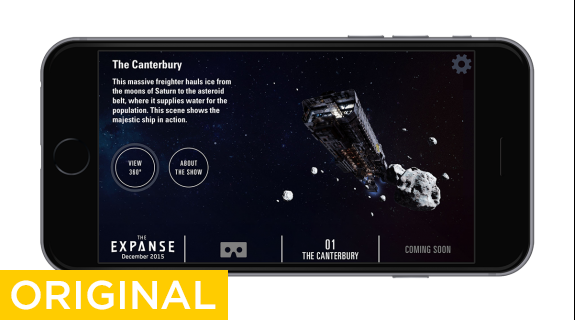Amidst the ever-loudening sprawl of stimuli at this years’ San Diego Comic-Con, at least one small corner offered fans something a bit more introspective. In Mary Jane’s Café at San Diego’s Hard Rock Hotel, Syfy had an activation for its upcoming space drama The Expanse. There, the network had on hand 13,000 free Google Cardboard viewers, and anyone who dropped by could pick one up, assemble it and then use it to engage with the new virtual reality app, Expanse VR.
What those attendees saw, and what anyone with an iOS or Android device can now see (no Cardboard required, though it is highly recommended) was another, even smaller corner of an even vaster realm than Comic-Con – a tiny patch of space near Saturn, centered around a ship called the Canterbury, a vessel that will be featured prominently in The Expanse when it premieres this December. The experience as it currently stands involves a very brief voice-over providing a bit of context to what you are seeing, but mostly you just hover there, floating around the vessel while moving your head or hands to alter directions and angles. In its current form, the Expanse VR app offers nothing more than the chance to look at the exterior of a spaceship, but that effect approaches the quiet, immense profundity of space itself.
“We’ve been playing with Cardboard for quite a while now,” said Matthew Chiavelli, SVP of Syfy Digital, reflecting on the activation, “but for a lot of people [Comic-Con was] their first experience with it. It’s deceptively impressive when you first experience it and you look at this thing that looks like literally a piece of cardboard, but you can really get lost in the experience.”

Syfy and NBCUniversal Media Labs partnered with IM360 to develop The Expanse VR, who in turn collaborated with visual effects company Digital Domain to render the photo-realistic ship.
In general, said Chiavelli, “CG work that is done for TV or movies is intrinsically 3D anyway and then they sort of flatten it out when they render it out for the scenes that you see on the TV screen.”
But IM360 got to work in close conjunction with the production’s actual VFX team, giving them access to the same assets that will actually be featured in the show.
“To be able to take advantage of these really detailed 3D models and use them in 3D was kind of a treat and I think everyone involved was really psyched to be working with assets that were this detailed,” Chiavelli continued. “The Expanse is probably one of the more visually stunning shows we’ve done in quite some time, and having these really detailed assets to work from let us give them to the fans in a way that they’re not even going to be able to experience on television.”
While any real-life environment could conceivably be rendered in virtual reality, places in which one floats seem like particularly well-suited outlets for the technology. Simply the act of circling the Canterbury is exciting and if you position yourself just right, it almost seems like you could float right inside it, which is exactly what Syfy has in store for us next.
“We’re looking now at being able to look at more of the interior of one of the ships,” said Chiavelli.
Where most apps keep updating with new features and improved usability, virtual reality apps can update with new environments, each one taking the viewer deeper into the world of a show than ever before.
Tags:












































__twocolumncontent.jpg)











